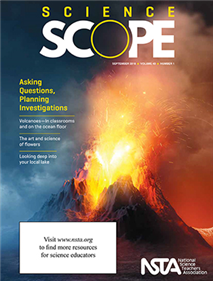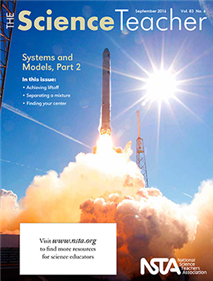All Resources
Journal Article
Bringing the Maker Movement to School
Fourth-grade students create projects to illustrate the transfer and transformation of energy....
Journal Article
Investigating Axial Seamount: Using Student-Generated Models to Understand Plate Tectonics
Teach students to use their own models as tools for constructing a scientific explanation of a natural phenomenon....
Journal Article
Feet Wet, Hands Dirty: Engaging Students in Science Teaching and Learning With Stream Investigations
Stream investigation and restoration projects offer unique experiential opportunities to engage students in outdoor learning experiences that are relevant to the communities in which they live. These experiences promote an understanding of watershed...
Journal Article
Adaptations create science conventions that avoid the typical pitfalls of science fair time....
Journal Article
Celebrating Science With the Community
An approach to science fairs intended to create learning celebrations....
Journal Article
Primary students explore connections between science and writing....
Journal Article
The Early Years: Classroom Memories
This column discusses resources and science topics related to students in grades preK to 2. This month’s issue provides an activity to encourage students to reflect on their actions and thought processes....
Journal Article
Editor's Note: Creating Meaningful Products
Science and Children’s editor shares thoughts regarding the current issue....
Journal Article
Teaching Through Trade Books: What We Do With Ideas
This column includes activities inspired by children’s literature. This month’s issue focuses on allowing students to expand their thinking around simple objects and ideas while maintaining a science focus....
Journal Article
The Poetry of Science: Sinking and Floating
Build literacy in playful, meaningful ways with sinking and floating....
Journal Article
Science 101: What Constitutes a Good Science Project
This column provides background science information for elementary teachers. This month’s issue discusses the elements of a good science project....
Journal Article
This column shares exercises to challenge content knowledge. This month's issue presents a new challenge and answers The Speed of Light challenge from last month....
Journal Article
Engineering Encounters: Designing Healthy Ice Pops
This column presents ideas and techniques to enhance your science teaching. This month's issue shares information about a STEM enrichment project for second graders that incorporates nutrition and design principles....
Journal Article
Methods and Strategies: Science Storybooks
This column provides ideas and techniques to enhance your science teaching. This month’s issue discusses using Giverny Award winners to engage elementary students in science....
Journal Article
A Middle School Lake Study: Connecting Disciplines Through a Hands-On Experience
Dip into this cross-disciplinary, hands-on exploration of a local lake that can lead to a community learning experience....
Journal Article
A Closer Look at Flowers: Exploring Structure and Function in Science and Art
Integrate art into a 5E model unit on the anatomy of flowers to provide students with another lens through which to view the specialized structures and organization of flowering plants....
Journal Article
From the Editor's Desk: A Welcome From the New Editor
Science Scope’s editor shares thoughts regarding the current issue....
Journal Article
Teacher to Teacher: Start the School Year With an Authentic Activity
This column provides practical advice from your peers. This month's column provides an activity to engage students in scientific argumentation....
Journal Article
Disequilibrium: Teaching Discrepant Events With the 5E Instructional Model
This column shows how to use discrepant events to confront misconceptions. This month's issue takes a vinegar–baking soda activity through the various stages of the 5E Instructional Model....
Journal Article
Science for All: Creating Student Buy-In on Day One
This column shares strategies for increasing student engagement. This month's issue discusses how to engage students at the beginning of the school year....
Journal Article
Listserv Roundup: A Definitive Guide to the NSTA Listservs
This column shares recent conversations taken from the NSTA listserv community about current science education topics....
Journal Article
Classic Lessons 2.0: The Power of Nanoscale
This column shares updated perennial classroom favorites. This month's issue describes activities in which students examine how the ratio of surface area to volume is related to the size of an object, a concept that allows nanoparticles to react quic...
Journal Article
Teacher's Toolkit: A Bird in the Cage Is Worth Two in a Bush
This column provides how-to strategies and practical advice for the science teacher. This month’s issue explores how Science Snacks can provide an opportunity for students to engage in the NGSS practice of Planning and Carrying Out an Investigation...
Journal Article
Citizen Science: Testing the Water: World Watering Challenge
This column highlights formal and informal science research projects that students can join and contribute to by gathering and sharing data. This issue discusses a global citizen science program that allows students from around the world to monitor l...
Journal Article
Scope on the Skies: Angles and Eclipses
This column focuses on astronomy throughout the year. This month’s issue discusses types of angles and eclipses, and modeling planets....






